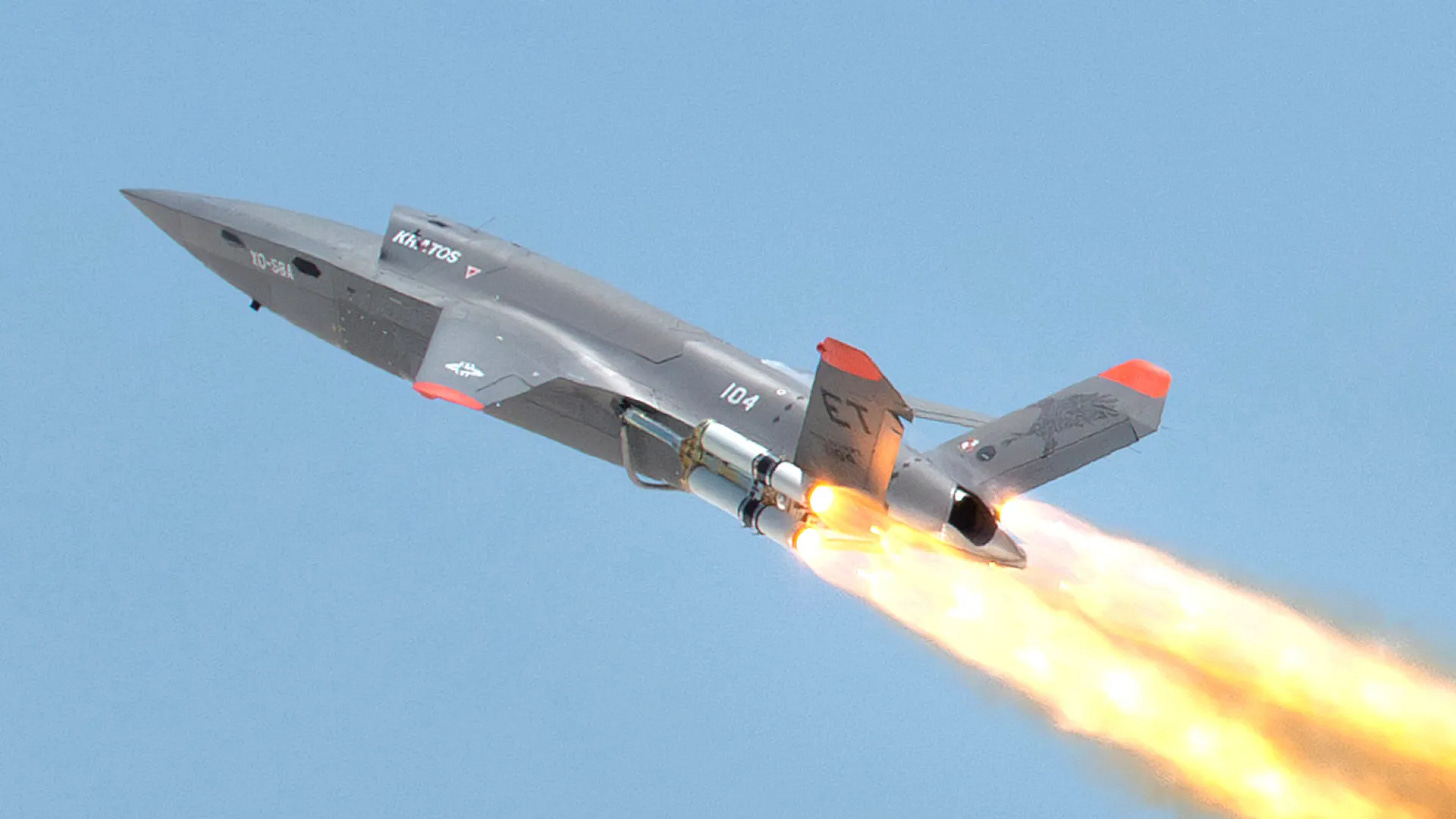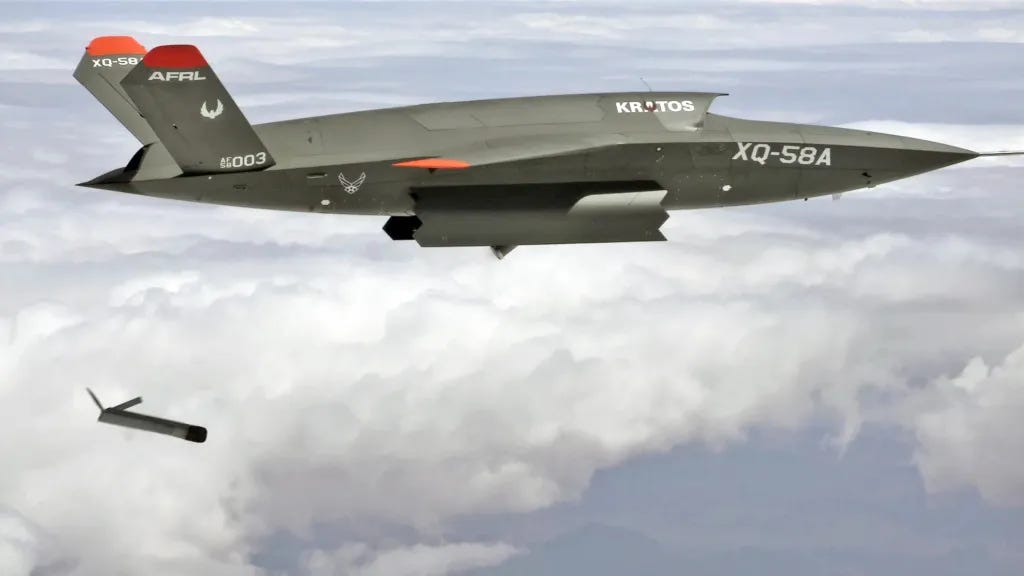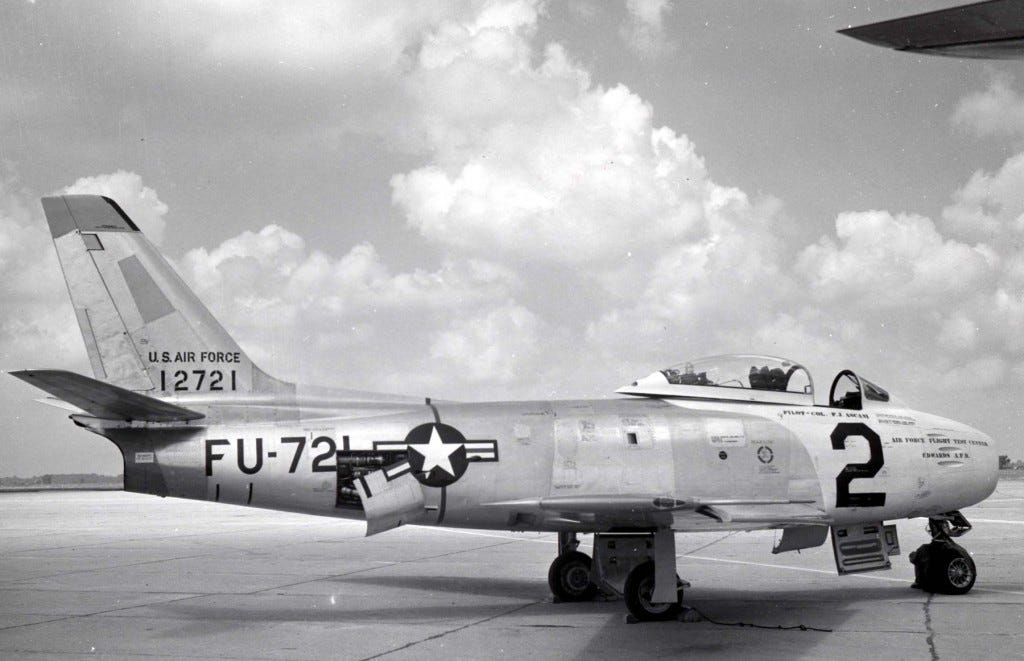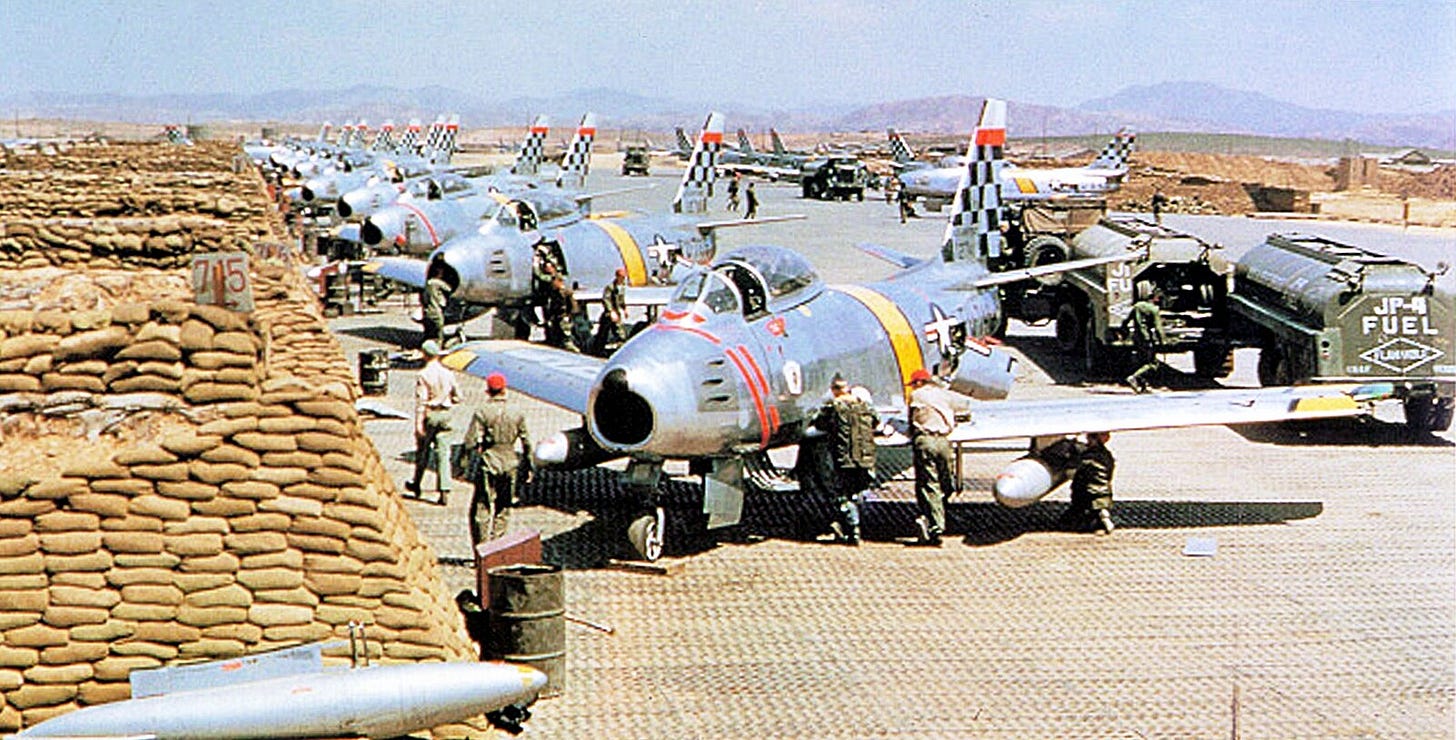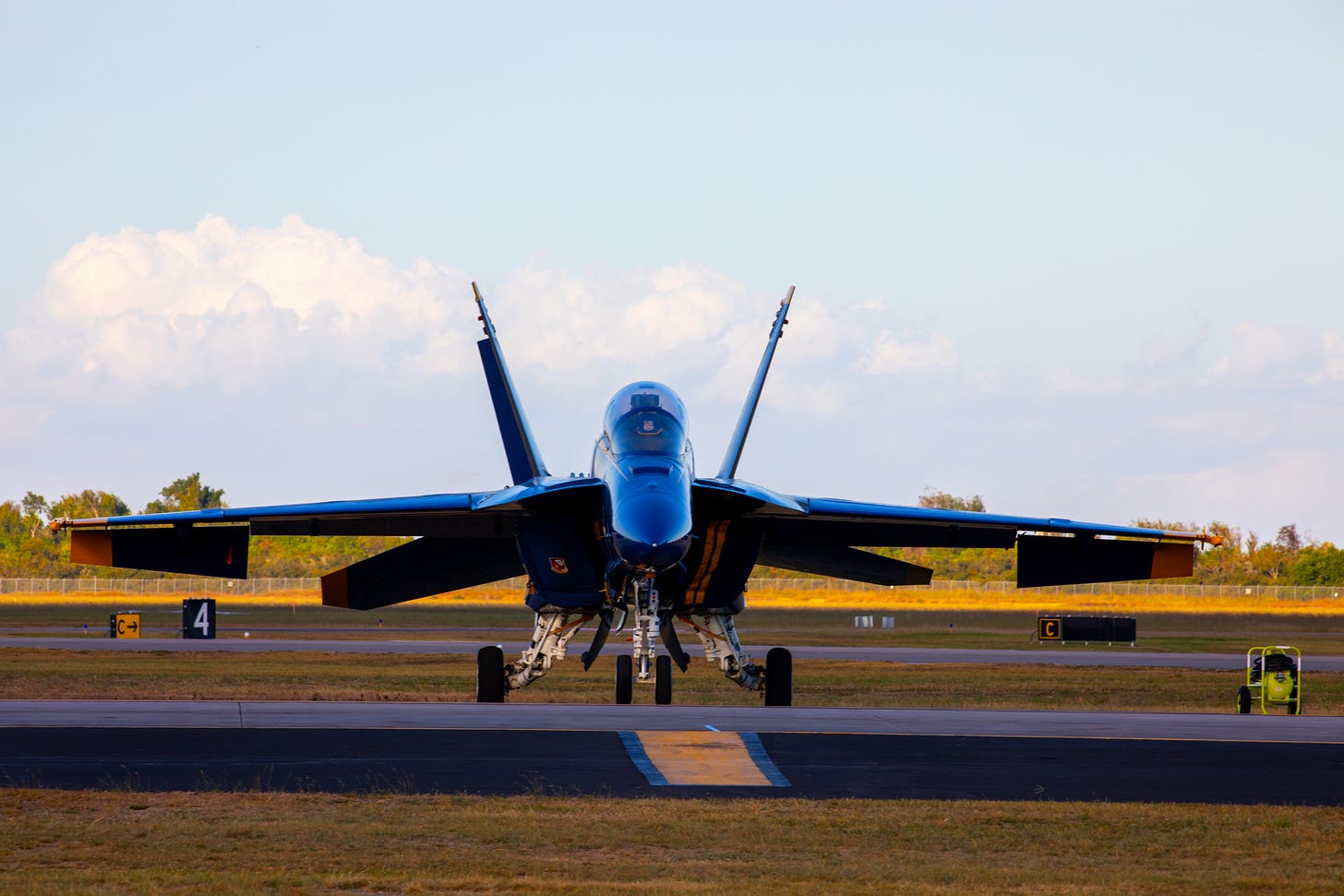Valkyrie Goes Global, Sabre Sets the Pace
From cutting-edge combat drones to Cold War speed records, this week connects the future of airpower with its legendary past.
“Valkyrie exists, is flying, and has been flying since 2019.”
— Eric DeMarco, Kratos CEO
Mission Briefing
The stealthy XQ-58A Valkyrie drone is quickly moving from an experimental platform to a production-ready family of aircraft with multiple customers in sight. Kratos, the manufacturer behind the Valkyrie, revealed last week that the U.S. Marine Corps is preparing to adopt it as a program of record—the first Collaborative Combat Aircraft (CCA) to reach operational service for the Marines. At the same time, Kratos has struck a deal with Airbus to create a European-focused variant for the German Luftwaffe, with expectations for fielding by 2029.
Kratos CEO Eric DeMarco confirmed that at least 24 additional Valkyries are already in long-lead planning, with the possibility of expanding the run to 48 aircraft. These will include multiple variants:
Runway-independent versions using rocket-assisted launch and parachute recovery
CTOL (Conventional Takeoff and Landing) models with tricycle landing gear
Hybrid runway-capable/runway-independent designs
A European-tailored configuration in partnership with Airbus
At least two undisclosed variants aimed at new customers
DeMarco hinted that Kratos is in a sole-source position with two other international buyers, though details remain classified.
Combat-Ready Features
The Marines have focused heavily on electronic warfare roles for the Valkyrie, with future configurations expected to add kinetic strike capability. The drone has already demonstrated the ability to drop munitions and even deploy smaller drones—such as the ALTIUS-600—from its internal bay. Kratos has also shown renderings of Valkyries carrying AIM-120 AMRAAMs underwing, hinting at an eventual air-to-air role.
The Marines are reportedly interested in landing gear-equipped versions to support expeditionary operations, while Airbus’ European model is being designed with an open, “platform-agnostic” system architecture to integrate NATO mission systems.
The Bigger Picture
Since its first flight in 2019, the Valkyrie has flown alongside F-35s and F-22s, proving itself in manned-unmanned teaming missions. Unlike paper concepts, Kratos stresses that the Valkyrie is already flying, already integrating, and represents an attritable, combat-ready drone.
Still, Kratos faces competition. The U.S. Air Force passed it over for the initial CCA tranche, instead selecting designs from General Atomics (YFQ-42A) and Anduril (YFQ-44A). But the Air Force has signaled that future tranches may prioritize cheaper, less “exquisite” systems—exactly the lane where Valkyrie excels.
As DeMarco put it, “Valkyrie exists, is flying, and has been flying since 2019… This is why Airbus partnered with Kratos.”
For the Marines, NATO, and potentially new Pacific customers, the Valkyrie is quickly shaping up to be more than just a test article—it’s becoming a global combat drone family.
At a Glance: XQ-58A Valkyrie
Role: Stealthy, attritable Collaborative Combat Aircraft (CCA)
First Flight: 2019
Developer: Kratos Defense & Security Solutions
Key Features
Launch Options: Rocket-assisted launcher, parachute recovery, or CTOL with landing gear
Payload Flexibility: Internal bay for small drones (e.g., ALTIUS-600) and precision munitions; wing stations for missiles like AIM-120 AMRAAM
Roles in Testing: Electronic warfare, manned-unmanned teaming, strike missions, and payload deployment
Range: ~3,000 nautical miles (with drop tanks)
Speed: High-subsonic (exact figures classified)
Current Operators:
U.S. Air Force (test & evaluation)
U.S. Marine Corps (transitioning to program of record)
On the Horizon:
Airbus partnership → European/NATO-tailored Valkyrie for the German Luftwaffe by 2029
Two undisclosed international customers in sole-source talks
Production ramp-up: 48 Valkyries planned across multiple variants
This Week in Aviation History
August 17, 1951 – The Sabre Sets the Pace
In the summer of 1951, the United States Air Force was eager to showcase its newest frontline day fighter—the North American F-86E Sabre. The stage would not be a battlefield, but rather the prestigious National Air Races in Detroit, Michigan. To prove just how capable the jet was, Colonel Fred J. Ascani, Vice Commander of the Air Force Flight Test Center at Edwards AFB, was tasked with something bold: set a world speed record.
Two fresh Sabres were pulled directly from the production line at North American Aviation’s El Segundo plant. Painted with striking orange accents and numbered “2” and “4,” these weren’t exotic prototypes—they were stock aircraft, the same kind being sent to Korea. Flying aircraft #2, F-86E-10-NA serial number 51-2721, Ascani blazed through a 100-kilometer closed circuit at an average speed of 1,023 km/h (635.7 mph). His flight shattered the Fédération Aéronautique Internationale record and underscored American air superiority in the early jet age.
For his achievement, Ascani earned both the Thompson Trophy and the Mackay Trophy, cementing his place in aviation history. The feat was especially important to the Air Force—it proved that the Sabre wasn’t just combat-capable, but also the fastest fighter of its time.
The Jet That Changed the Game
Designed by Edgar Schmued—the same man behind the legendary P-51 Mustang—the F-86 brought swept-wing technology into frontline service. Borrowing from captured German research, the Sabre’s 35° swept wings delayed compressibility effects at transonic speeds, making it far more capable in high-speed flight than its straight-wing predecessors.
The F-86E, the variant Ascani flew, introduced a revolutionary all-flying tailplane—a fully movable horizontal stabilizer that gave pilots precise pitch control at near-supersonic speeds, where conventional elevators often became unresponsive. Powered by a General Electric J47 turbojet, the Sabre could reach nearly 680 mph at sea level and climb into the thin air above 47,000 feet.
Armed with six .50 caliber Browning machine guns, the Sabre was not only fast but lethal. It would prove itself decisively in the skies over Korea, going head-to-head with the Soviet-built MiG-15 in what became known as “MiG Alley.”
Into Combat
To reinforce that Ascani’s record was no one-off stunt, his record-setting Sabre was promptly sent to the Korean front. Assigned to the 25th Fighter Interceptor Squadron, 51st Fighter Interceptor Wing, at Suwon Air Base, the jet was given a fitting name: “THIS’LL KILL YA.”
It flew combat missions until 1953, when it was damaged in a landing accident at Kimpo Air Base. Repaired and returned to service, the aircraft continued its career—a testament to both the ruggedness and frontline relevance of the F-86E.
In all, more than 8,600 Sabres were built by North American and international partners, making it one of the most produced and widely flown jet fighters in history. But on that day in August 1951, it was Colonel Ascani and a factory-fresh Sabre that showed the world just how fast the jet age had arrived.
Sidebar: Sabre vs. MiG
The Korean War became the proving ground for the F-86 Sabre and its Soviet-designed rival, the Mikoyan-Gurevich MiG-15. Their clashes over “MiG Alley” in northwestern Korea marked the first large-scale jet-versus-jet combat in history.
North American F-86E Sabre
Engine: General Electric J47 turbojet, ~5,200–6,000 lbs thrust
Max Speed: ~679 mph (1,092 km/h)
Service Ceiling: 47,000 ft (14,326 m)
Armament: Six .50 caliber Browning machine guns
Advantage: Superior handling at high speeds, advanced all-flying tailplane, better diving performance
Mikoyan-Gurevich MiG-15
Engine: Klimov VK-1 turbojet (derived from Rolls-Royce Nene), ~5,950 lbs thrust
Max Speed: ~668 mph (1,075 km/h)
Service Ceiling: 51,000 ft (15,545 m)
Armament: One 37 mm cannon + two 23 mm cannons
Advantage: Faster climb, higher ceiling, devastating firepower against bombers
The Edge:
While the MiG-15 could out-climb and out-gun the Sabre (at least on paper), U.S. pilots gained the upper hand through superior training, radar control, and tactics. Sabre pilots claimed a kill ratio of 10:1 over MiGs—a figure still debated, but one that cemented the Sabre’s reputation as America’s first great jet fighter.
In Case You Missed It
Photo Outlet
Every issue of Hangar Flying with Tog gets you a free image that I’ve taken at airshows:
Feel free to use these photos however you like, if you choose to tag me, I am @pilotphotog on all social platforms. Thanks!
Post Flight Debrief
Like what you’re reading? Stay in the loop by signing up below—it’s quick, easy, and always free.
This newsletter will always be free for everyone, but if you want to go further, support the mission, and unlock bonus content, consider becoming a paid subscriber.
Your support keeps this flight crew flying—and I couldn’t do it without you.
– Tog



